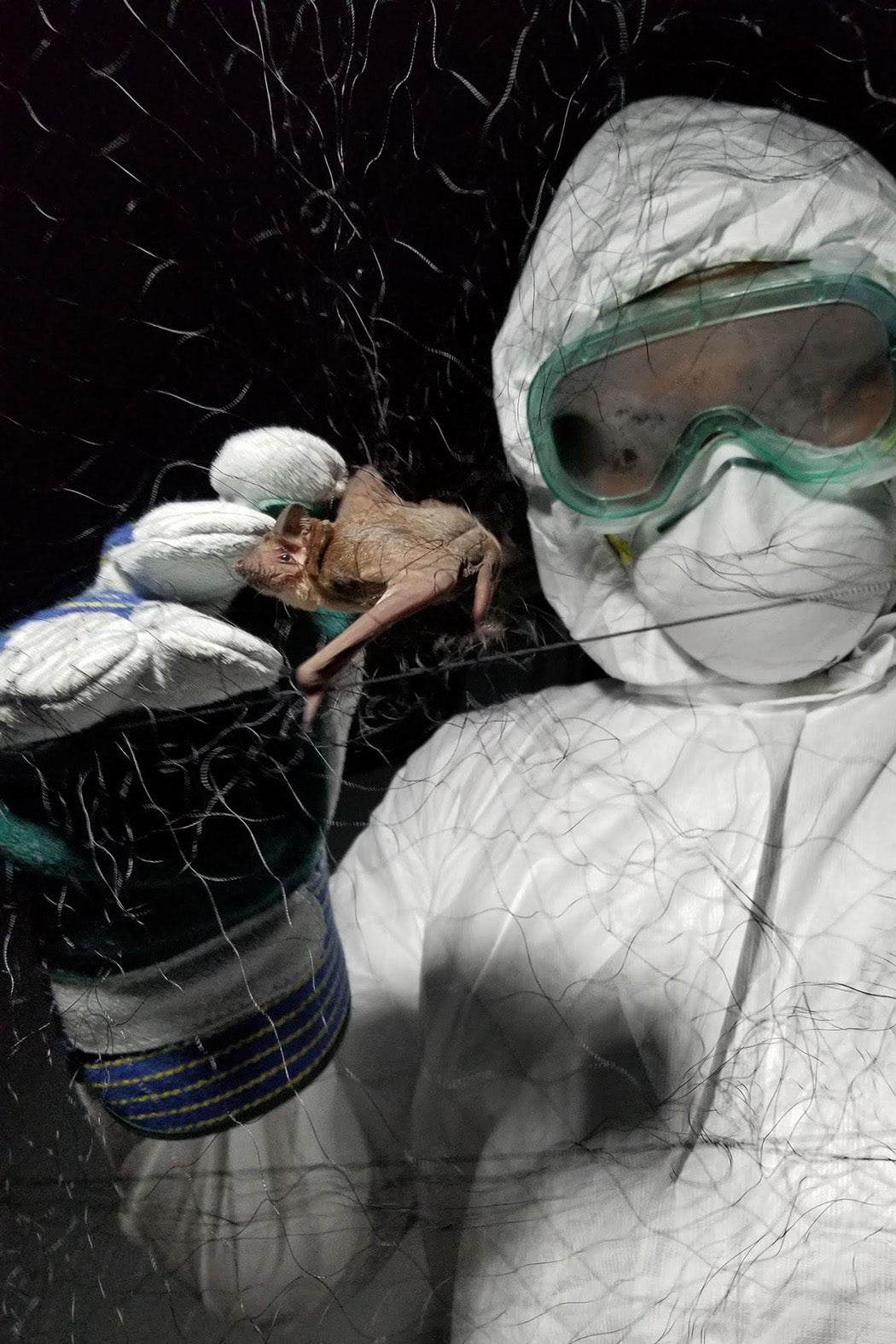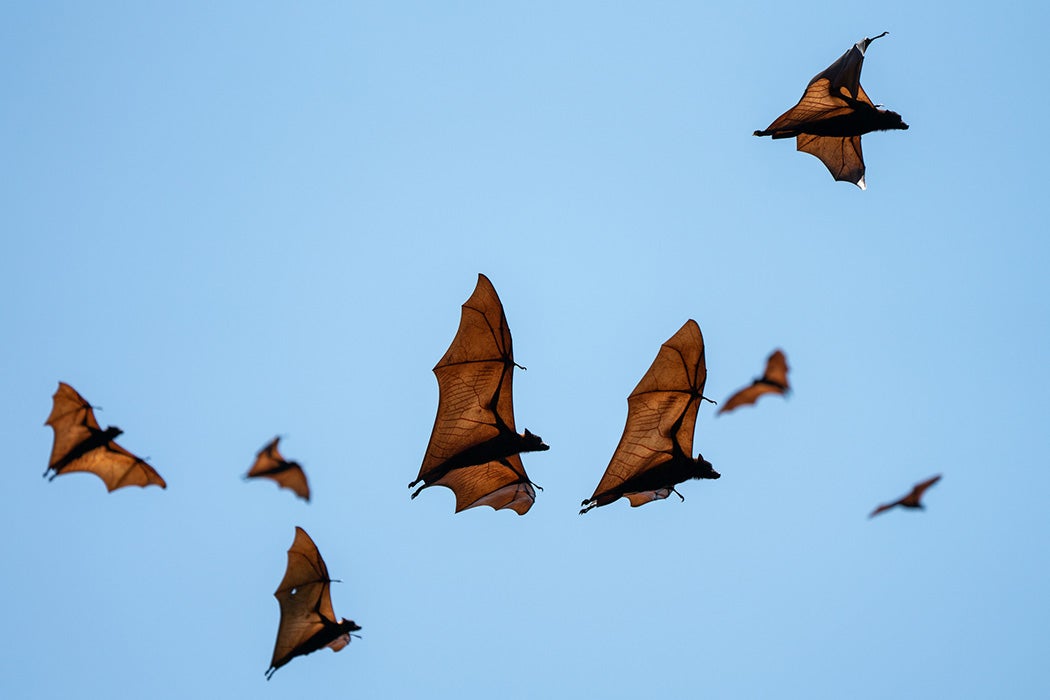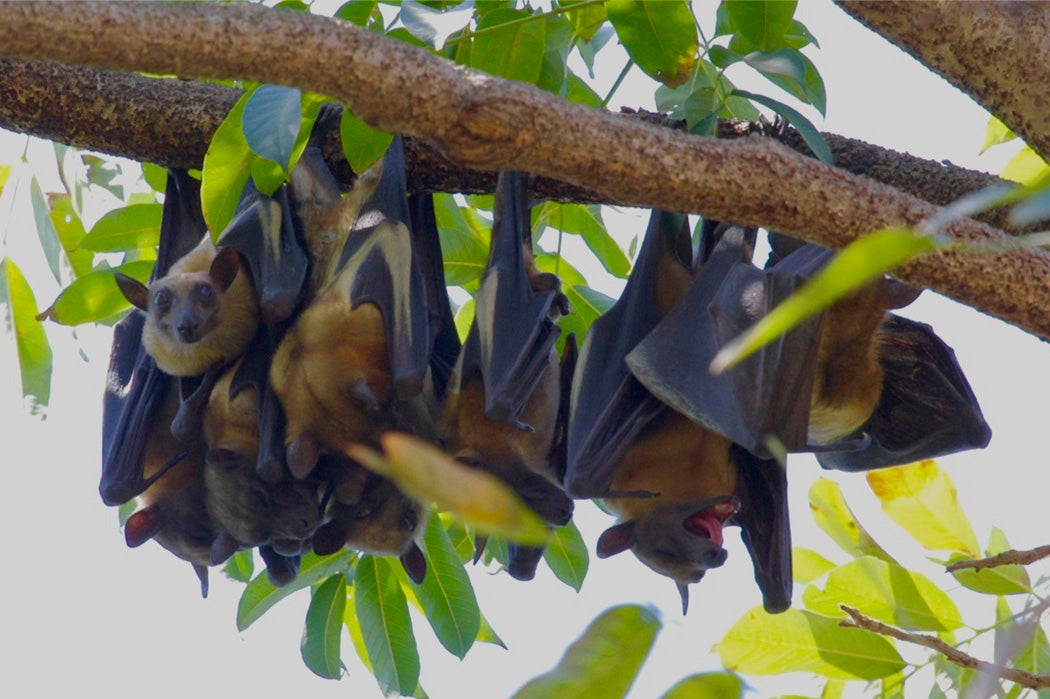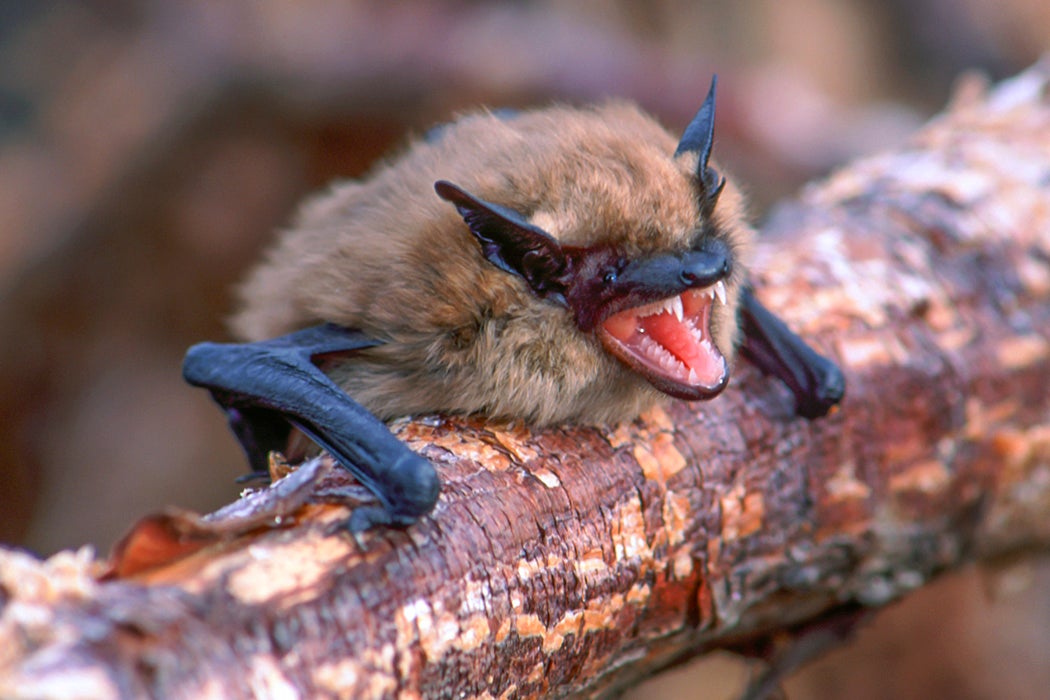The cave was huge and full of bats dangling upside down from the ceiling. It was a mind-boggling sight—tens of thousands of furry flighty creatures with wingspans the length of a chicken’s. The smells and the sounds were overwhelming. It was as if an entirely new world had just opened up.
Brian Bird, who specializes in veterinary medicine and virology at the University of California, Davis, had been studying bats and other wild creatures for a while, but that sight stuck with him for years. His team had been working in Uganda investigating an outbreak of the Marburg virus, Ebola’s close cousin, and found a cave where the creatures carrying the virus, roosted. The cave had an opening large enough for the scientists to walk through in full protective gear, so that’s what they did. What they found inside beat all expectations. “The cave opened up into a magnificent cavern underneath a mountain, as if the mountain itself was hollow,” Birds recalls. “And it was filled with Egyptian fruit bats, tens of thousands of them. You were suddenly inside the world of these big bats.”
Bird, who is associate director at One Health Institute was also a researcher for the USAID-funded PREDICT, a program that was established to identify and combat emerging infectious diseases. Bats are known to carry quite a number of pathogens dangerous to humans, so they fall under such surveillance. Bird’s efforts focused primarily on Africa, where many bat species live.

To study the creatures and the viruses they carry, the team would stretch out nets across bats’ flying paths—between trees or across the caves’ openings, depending on where the species roosted. As bats flew out to forage at dusk, they would get caught. Clad in Tyvek suits, N95 masks, thick leather gloves and protective glasses to avoid any possible aerosol contacts, the scientists would disentangle them gently, scoop them into cloth bags akin to pillowcases, and then remove them slowly—to weigh, measure, and take swabs of their saliva and feces. Sometimes the creatures would fight or try to bite. “We’d let them bite onto the leather gloves because it would calm them down,” Bird reveals, “but we tried to do everything with as little disruption to their lives as possible.” Once researchers were done, they’d let the creatures out and later test the samples for viral presence.
PREDICT’s efforts span a gamut of goals. It aimed to train an army of wildlife surveillance professionals in 30 different countries to keep an eye on emerging infections. It also identified what viruses various species carry, including many novel ones. “We discovered well over 1000 novel viruses—more than we knew when the program first started,” Bird recalls. The project also informed scientists what viruses the creatures could harbor, without falling dangerously ill. Understanding how bats keep these viruses at bay could help us build better immune defenses to viral infections, including the novel coronavirus that brought the world to a standstill.
Enter the SARS-CoV-2
The SARS-CoV-2 trajectory in the human body is well documented. The now-infamous thorny spiky sphere has a molecular knack for entering human cells by binding to an ACE2 receptor commonly found on various cells’ surfaces. Once inside, the virus takes over the cellular machinery and begins making copies of itself. When the new viral particles are assembled, they usually burst out of the cell, killing it—and go on to invade more cells. The infected cells shout to the immune system and in response, it rolls out the big guns—the B-cells, which produce antibodies, and T-cells that kill the viral invaders along with the infected cells of the lungs or other tissues.
This defense response is triggered by the so-called inflammatory cytokines, molecules that promote inflammation necessary to kill the virus, but in some people, the process spins out of control. The overzealous immune system triggers so much inflammation that it damages the body’s own tissues and organs, which could be lethal. “The majority of symptoms caused by highly pathogenic coronaviruses like SARS or SARS-CoV-2 in humans is driven by the over- inflammation in the body,” says virologist Arinjay Banerjee, postdoctoral researcher at McMaster University in Canada.
Meanwhile, bats, which are natural hosts for many coronaviruses—including the SARS-like ones—keep them at bay without becoming severely ill. “They may be infected but they don’t develop the clinical symptoms of the disease,” Banerjee explains. Unlike humans, bats don’t develop an outsized immune system response. The hypothesis is that they somehow suppress the inflammation and co-exist with the viruses.
This remarkable infection tolerance is not the only thing that sets bats apart. Bats are amazing creatures for many reasons. They are the only true flying mammals on Earth. “There are over 1400 knows species of bats—and we are discovering new ones all the time,” Banerjee says. Their variety is mind-boggling. Kitti’s hog-nosed bat, the smallest of the species and also likely the world’s tiniest mammal, is about the size of a large bumble bee weighing a mere two grams—same at two Skittles. In comparison, the largest bat—Pteropus vampyrus in Asia, also known as the flying fox—has a wingspan of five and a half feet, comparable to human height. When airborne, the flying fox looks like a Lost World pterosaurs that mistakenly fluttered into our own era—except that the prehistoric flyers were reptiles and bats are mammals.

Flying, which is a special talent no other mammal managed to evolve, has shaped the bats’ evolution in unique ways. Because flying takes a lot of energy and calories, all bats are lightweight and have extremely high metabolisms. They age very slowly, don’t develop chronic inflammation, and virtually never have cancer. In human and mammal genes, the chromosomes have protective structures called telomeres, which wear out and shorten with time, causing cells to age. But in some bat species telomeres never shorten—it is as if the creatures got an immortality gift from Mother Nature. Compared to similar-sized animals, they live remarkably long lives—researchers found one Siberian bat that lived over 40 years. In comparison, mice live for three years, and usually less.
While enjoying such longevity, bats are also able to tolerate a variety of viruses—not only the Coronaviruses, but also other, more vicious ones. They coexist with viruses that are extremely deadly to humans. For instance, bats carry the Nipah virus, which periodically leaps onto humans with 75 to 100 percent fatality rate. Bats also tolerate the Hendra virus, which also occasionally spills over to humans, and coexist with Ebola and its relative, the Marburg virus. Even the rabies virus, which is typically lethal for all mammals, doesn’t always kill the bats—depending on the seasons and other conditions, they can successfully develop immunity to it.
But unlike mice, the veritable workhorse of scientific research, bats can be difficult to study. There are few captive breeding bat colonies because the creatures are difficult to raise in captivity. They also pose health risks because of the diseases they carry. So instead of investigating how bats defeat viruses in vivo, Banerjee and other virologists study how bat cells fight off viruses in a petri dish. And they have some ideas what makes bats so good at it.
The Politics of Interfering
To keep the viruses in check, bat cells produce molecules called interferons, which trigger a chain reaction that interferes with viral replication. Unlike antibodies that coat the viral particles, preventing spike proteins from latching onto our cells, the interferons don’t tackle the virus directly. Instead, interferons stimulate a number of genes within cells to generate substances that gum up the virus’s replication gears. “Interferons themselves are not protective, but they stimulate other genes called interferon-stimulated genes, or ISGs,” Banerjee says, comparing interferons to a battery that starts a car. “Interferons are kick-starters for these ISGs genes. Without the battery your car doesn’t start, and once the car starts, you no longer need the battery for the engine to run.”

Bats aren’t unique in producing these molecules. Humans produce interferons too—and such molecules play a crucial role in defenses against the coronavirus. Scientists at the Rockefeller University have discovered that patients who lacked type I interferon, a set of 17 proteins that help defend the cells and the body, had more severe Covid-19 symptoms, and more deaths too. Using blood samples from patients hospitalized with severe COVID and from people with asymptomatic infections, the team ran a genetic comparison. They found that those with severe disease had rare variants in the 13 genes involved in the interferon pathway and over three percent of them were missing a functioning gene altogether. Over ten percent of severely-hit patients had misguided antibodies that neutralized these interferons—a problem that researchers described as an autoimmune condition. These findings help explain why some young and healthy individuals wound up in ICU and on ventilators, while others didn’t develop symptoms at all.
But while type I interferons are the first line of antiviral defense in all mammals, bats have many more interferon-producing genes than humans. In fact, some bat species have dozens of interferon-generating genes. Pteropus vampyrus, for example, has 61 type I interferon genes, according to one study. So does the little brown bat, Myotis lucifugus.
Flying may also factor into the bats’ antiviral response. “When bats fly, their metabolic rates go through the roof and their body temperature increases up to 41C, it’s like fever,” Banerjee says. Scientists hypothesize it may work as another antiviral defense, although the mechanisms of it aren’t fully understood. But one thing is clear. Bats’ immune systems are superior to ours in their viral defense balance, which makes them important research subjects. An international project run by the Centre for Irish Bat Research at the University College, Dublin in Ireland wants to sequence all bat species in the world and catalogue their genomes. Called the Bat1K Project, it aims to sequence the known bat species in hopes of understanding how their genes work—and possibly use the knowledge to create medicines for humans.
Peaceful Coexistence
Scientists estimate that up to 75 percent of emerging infectious diseases are zoonotic, meaning that they are caused by pathogens leap from animals to humans. And the frequency of outbreaks caused by zoonotic pathogens has been increasing. It is, at least in part, due to the expanding human population, which encroaches on wildlife habitats, including bats. Clear cutting forests where some bat species live, or mining, which destroy caves where other species roost, pushes the creatures to move to new places, often near humans. In some places people also hunt bats for food—and have been for generations.
Ecological disasters play a role too. When in 1997, massive fires destroyed large areas of Indonesian forests, the fruit bats that foraged there had to find new sources of food. They found good eating among the mango trees of the pig farms. When pigs ate the fallen fruit previously bitten by bats, they picked up the Nipah virus, which they passed onto humans, causing an outbreak.
Notably, not all close contacts cause outbreaks, Bird says. In fact scientists sometimes wonder why outbreaks aren’t recognized more often, particularly in places where people hunt bats, or harvest fruit bitten by them or use their droppings as fertilizer. Part of the reason is that while the bats carry these viruses, they don’t always shed them into the environment. The shedding may be seasonal, Bird says. For example, the Marburg virus-carrying bats have two breeding seasons a year, and it is mostly the juvenile bats that shed the virus. When baby bats arrive, they receive the antibodies against the viruses with their mothers’ milk, just like humans do, but once they are weaned, they become susceptible to infections. As their immune systems mature, it gets the viruses under control, but during their juvenile phase, the young can shed viruses. And even when an infectious bat bites a mango, the virus may deactivate in the sunlight before a human eats it. Lastly, not all viruses bats carry are deadly to humans. There are examples of Ebola that aren’t pathogenic to people, Bird says.
Weekly Newsletter
Populations that live in close proximity to bats sometimes know how to coexist with them safely—such as not to disturb during certain seasons. But as the human population continues to grow, destroying bat habitats and pushing them into new places, the number of these spillover events will likely increase—and the chances of pandemics will too. What’s the best way to prevent them? Peaceful co-existence—meaning avoiding habitat destruction—is one good policy. The other is education and awareness of the populations living in close proximity to bats and other creatures—particularly where bats still serve as a food source. “A lot of cultures eat bats,” says Bird—and that’s not something that can change overnight. “We eat the foods we eat because our parents did—cultural changes occur slowly. So projects like PREDICT are working hard to figure out how to deliver the message about living in harmony with the environment and the species.”
The last piece of the prevention puzzle is surveying wildlife that carries pathogens dangerous to humans. That can inform scientists about what new disease might emerge one day. And knowing how bats and other wild creature interfere with their infections would help scientists interfere with ours—curtailing an outbreak before it becomes a pandemic.







